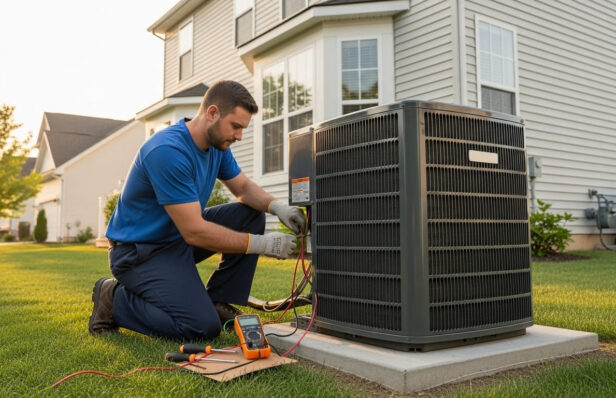Master the Art of Lawn Mowing: An All-inclusive Guide
As a kid, the sight of my father walking behind his push mower, creating neat rows of freshly cut grass, was one I cherished. It seemed to be a magic trick in slow motion; the yard transforming from an unruly jungle to a manicured oasis right before my eyes. Now, as an adult, I’ve inherited his thrill for lawn care, and I know there’s more to mowing grass than merely cutting it down to size.
Proper lawn maintenance is more than aesthetics; it plays a key role in preserving the value of a property. The condition of your lawn can often influence first impressions and affect the overall perception of your home. Therefore, mastering the art of lawn mowing can provide a greater understanding and appreciation for what that lush green grass underfoot truly signifies.
The Importance of Regular Lawn Mowing-
A well-cared lawn is a happy lawn. Regular mowing is to turf care what consistent brushing is to dental hygiene. It keeps your grass healthy, lush, and less susceptible to pest invasions and diseases. More than this, the frequency of mowing promotes thicker growth by ensuring all grass blades get an equal amount of sunlight, resulting in a dense green carpet that’s quintessential of perfect lawns.
Further, mowing your lawn at the right frequency not only contributes to its visual appeal but also helps mold your yard into the landscape design of your dreams. The aim is to use mowing as a tool to shape your lawn into an extension of your personality, thereby imparting your yard with a distinctive charm.
Choosing the Right Tools-
Like any artisan, a lawn care enthusiast requires the right tools to create their masterpiece. The primary tool, of course, is the lawn mower. From the humble push reel mower to advanced battery-operated options, zero-turn mowers, and petrol-powered monsters, one is truly spoilt for choice.
Electric mowers are lightweight, silent, and ideal for small to medium-sized lawns. They produce less noise and air pollution but are limited by the length of their cord or the battery life. Petrol mowers, on the other hand, are powerful and ideal for large lawns. However, they can be pesky due to the noise, emissions, and regular maintenance. As for manual mowers, they are environment-friendly, silent, and provide excellent exercise but may require more time and effort to mow your lawn.
Understanding the Right Mowing Height-
Mowing height is tantamount to maintaining a healthy lawn. What seems like an insignificant detail can have profound effects on the longevity and vitality of your grass.
Cutting grass too short leaves it helpless against the brutal summer heat and encourages the proliferation of weed seedlings, a condition often referred to as “scalping.” Since photosynthesis, the process which allows grass to grow and thrive, occurs in the blade, shorter blades mean less capability for the grassroots to sustain their growth. Matching your mowing height with the type of grass in your lawn is critical to obtaining that lush green appearance.
When is the Best Time to Mow Your Lawn?
Weather, seasons and grass type govern the best time to mow your lawn. Ideally, mid-morning is the best time as the morning dew has evaporated, yet the harsh mid-day heat hasn’t started. Mowing when it’s too hot can cause the grass to lose too much moisture leading to dehydration.
In spring and fall, your grass is growing at its peak, so you’ll need to mow it once or twice a week. However, during the heat of the summer or the bitter cold winter, you can usually slow your mowing schedule down to once every two weeks or less, as the grass grows more slowly in these extremes.

Lawn Mowing Seaford
Lawn Mowing Techniques-
In the world of professional lawn care, mowing patterns are discussed with the same passion as recipes among gourmet chefs. They’re the secret sauce to a healthier and visually appealing lawn. Stripe mowing, spiral mowing, double cut or cross mowing- these aren’t fancy dance moves but time-tested techniques to keep your grass in top shape.
Stripe mowing is achieved by varying the direction of mowing each time to create dark and light patterns for a sleek look. Spiral mowing involves starting from the outside edge and mowing inwards in a spiral pattern, a method often used for large, round lawns. Double cut or cross mowing is essentially mowing your lawn twice in perpendicular directions. This is an excellent way to give your lawn a checkerboard-like finish while providing a thorough cut.
Lawn Care After Mowing-
Mowing isn’t the end of your lawn care. After-care is crucial in maintaining a healthy lawn. Once you’ve freshly cut the grass, it’s recommended to allow your lawn to recover before walking on it.
Watering is best done in the early morning hours to reduce evaporation and should only be done after allowing the lawn to rest for a while post-mowing. Fertilizing is another activity best done after mowing so that the nutrients can reach the soil and grassroots more efficiently.
Grass-cycling or leaving the clippings on the lawn acts as a natural fertilizer, supplying essential nutrients back into the soil, and can significantly reduce the need for synthetic fertilizers.
Tips for Common Lawn Problems-
Uneven growth, brown patches or thatching are all signs of a troubled lawn. Uneven growth can result from inconsistent watering or mowing, different types of grasses, or pests. For brown patches, usually signaled by a fungus problem, you might consider using a fungicide or applying a more organic approach like compost tea or neem oil.
Thatching, or having dead grass tangles near the soil, can cause irregular growth and disease. Regular mowing, aerating the soil and applying a top dressing of compost usually help combat these issues.
Mowing Safety Tips-
Safety should never be compromised when it comes to mowing. Be diligent about checking for debris in your lawn before you start. Rocks or toys can become a hazardous projectile if caught in the mower’s blade.
Always wear suitable clothing while mowing, including safety glasses, sturdy footwear, and long pants to safeguard against flying debris. It is imperative to keep children and pets inside when the mower is in operation for their safety.
Professional Mowing Services-
While DIY lawn care is rewarding, certain situations might mandate the involvement of professionals. Large lawns, lack of time, or physical limitations could require the need for a lawn care service. Always research and select a reputable service company based on online reviews, personal recommendations or testimonies from satisfied customers.
Wrap-up-
Mowing is more than a mundane chore; it is an essential ingredient in the recipe for a lush and healthy lawn. By understanding the importance of regular mowing, choosing the right tools for the job, knowing when and how to mow, giving due care post mowing, and addressing common lawn issues, you can master the art of lawn mowing.
Remember, no two lawns are the same. But with patience and practice, anyone can boast of a yard that not only adds to their home’s visual appeal but also becomes a place of pure delight that they can take genuine pride in. Happy mowing, folks!










